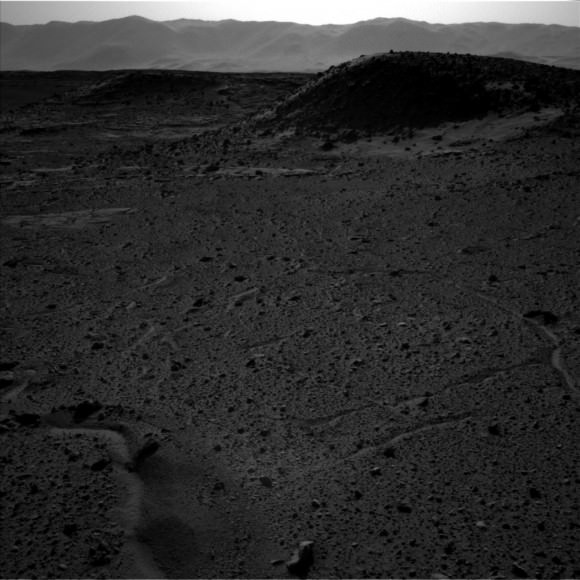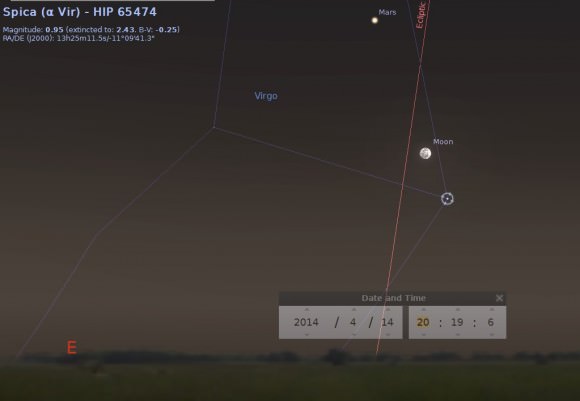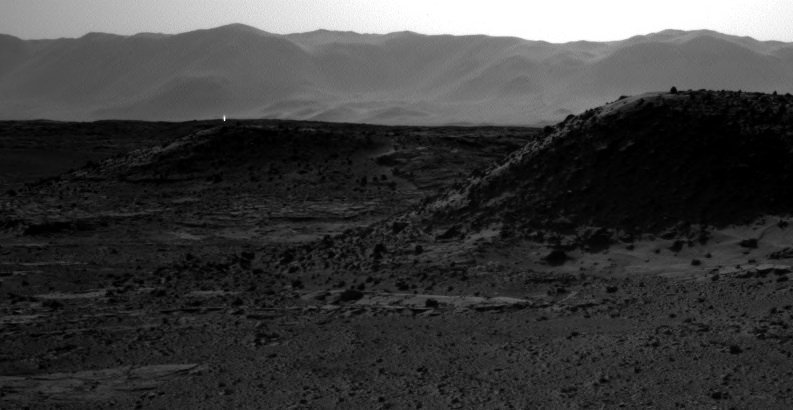Thanks to everyone who has emailed, Tweeted and texted me about the “artificial bright light” seen on Mars. And I’m so sorry to disappoint all the folks who were hoping for aliens, but what you see above is just an image artifact due to a cosmic ray hitting the right-side navigation camera on the Curiosity rover.
If you do a little research, you can see that the light is not in the left-Navcam image that was taken at the exact same moment (see that image below). Several imaging experts agree this is a cosmic ray hit, and the fact that it’s in one ‘eye’ but not the other means it’s an imaging artifact and not something in the terrain on Mars shooting out a beam of light.
Update: JPL imaging specialists with the MSL mission have now weighed in on these images. “In the thousands of images we’ve received from Curiosity, we see ones with bright spots nearly every week,” said Justin Maki in a press release from JPL. Maki is leader of the team that built and operates the Navigation Camera. “These can be caused by cosmic-ray hits or sunlight glinting from rock surfaces, as the most likely explanations.”
If the bright spots in the April 2 and April 3 images are from a glinting rock, the directions of the spots from the rover suggest the rock could be on a ridge about 175 yards (160 meters) from the rover’s April 3 location.
The bright spots appear in images from the right-eye camera of the stereo Navcam, but not in images taken within one second of those by the left-eye camera. Maki said, “Normally we can quickly identify the likely source of a bright spot in an image based on whether or not it occurs in both images of a stereo pair. In this case, it’s not as straightforward because of a blocked view from the second camera on the first day.”
There’s a great discussion and analysis of this going on at UnmannedSpaceflight.com, and they seem to be leaning towards the cosmic ray explanation.
You can see the whole series of images from the right Navcam here.

Cosmic ray hits happen frequently on spacecraft that don’t have the benefit of being in Earth’s thick atmosphere. And frequently, people seem to get excited about what shows up in imagery that have been affected. For example, one guy thought there was a huge base on Mars based on some he saw on Google Mars.
Getting hit by a cosmic ray can have some serious consequences for a spacecraft — sometimes it can put them into what’s called “safe mode” where only basic functions operate, or other times it can mess up data (like what happened with Voyager 2 in 2010 where the data sent back to Earth was unreadable). Usually, engineers are able to fix the problem and get the spacecraft back in working order.
Cosmic rays can even show up in imagery taken by astronauts on the International Space Station, like this one by astronaut Don Pettitt in 2012:

Astronauts also report seeing flashes — even with their eyes closed — whenever cosmic rays zip through their eyeballs. You can read more about that here.
And so far, none of these blips, lights or flashes seen on space imagery has ever been “because aliens.”
If you really want to see some amazing things, look at the imagery taken by Curiosity in its currently location on Mars. See all the raw images here, or see some really great colorized and enhanced versions on ‘amateur’ imaging blogs like those by Stuart Atkinson, James Canvin, Damia Bouic, Emily Lakdawalla at the Planetary Society, or the work done by Ken Kremer here on Universe Today.
Additionally, if you want to see bright lights associated with Mars, all you have to do is look up in the sky at night and see Mars shining brilliantly in the sky right now. Mars is in opposition, where it is closest to the Earth, and the “official” closest moment happens today, April 8th! Find out more about how to see it or watch different webcasts taking place today at our previous article here.

And for those of you who think we shouldn’t give “air time” to nutty claims like lights on Mars, it is our policy to address and debunk such claims (for example, see our article debunking the latest end of the world claim) in order to make sure the real story and good doses of reality are out there, too, and available to people who are looking for the real story.


Relieved to know that Martians haven’t adopted the dangerous Earth practice of shining laser pointers at vehicles
Grins and grunts… Thanks for the follow up Nancy! Cosmic Ray it is! When I wrote my little SciFi short story subject and attached it to Ken Kramer’s original article, I MADE SURE to mention that it was an ‘exercise’ in science fiction (Twice!). My intention is to inspire others to creative efforts. Done in ‘fun’, I hope I didn’t overstep UT’s posting rules? (Am I a Bad-daddy?) I will refrain from such activities in future if you prefer.
Still, the idea that an ETI might want to monitor our planetary explorations, sounds plausible if not a tad far fetched…
Such dogmatic certitude, Nancy, is hardly warranted. The explanation from NASA does not match yours. If it is a cosmic ray, you have a little coincidence problem — why is it that the light is directly on the horizon, and perpendicular to the horizon? That is something very unlikely to occur by chance if it were a cosmic ray (in which case it could appear anywhere on the image, with any orientation).
It might also be a rock sunlight reflection, except that it doesn’t look like such a glint. Reflected sunlight normally produces a kind of star shape.
I disagree. I copied the image and zoomed way in to see that the ‘light’ is pillar shaped, rather a vertical shaft. Just like a streak made by a cosmic ray hit on an imaging sensor would appear, coming from above. The location in the image, at the top of the distant ridge, is purely coincidental. But wouldn’t it be cool if it were something else? LOL… then more grins and more grunts. We wish…?
Hello marmah, I too felt similar seeing Nancy’s article a few weeks back on Pinnacle Island and the lawsuit by R Joseph alleging NASA didn’t properly investigate what he believed was a type of Martian fungus. I argued that based on a small handful of semi-closeup photos by Opportunity that we should keep an open mind until closer examination and sort of sided with R Joseph.
It turned out Nancy was right. A few weeks later NASA released photos of a hole closely matching the rock and supporting Squire’s theory of a wheel-turn induced rock flip.
In a world hungry for revolutionary scientific findings, sometimes we must settle for the evolutionary drip feed of discoveries that still provide great enlightenment.
Nancy is a straight shooter going with the explanations supplied by NASA. I dug deep on the Pinnacle Island finding because it bothered me so much.
It turns out that shortly after imaging the rock NASA fired the APSX on Opportunity’s arm at it. Also it turns out that Opportunity has a damaged robotic arm (being many years past is warranty), hence the lack of dozens of closeup photos (as opposed to what sounded a little like a conspiracy of silence as advanced by R Joseph).
The real problem is we generally only get the summaries and not all the info that went into the findings. NASA has experts, expert tools and techniques and these matter of fact statements usually turn out to be right…
Bottom line – Nancy reports it straight – nothing stops you investigating – google is your friend.
You yourself said it – cosmic ray strike could appear anywhere on an image – At this point a coincidence of ray strike artifact is far more likely than a martian disco on the horizon…
weeasle
The same apparent light on the horizon was shown one day earlier, in a different photo:
http://mars.jpl.nasa.gov/msl/multimedia/raw/?rawid=NRB_449700848EDR_F0301254NCAM00252M_&s=588
This photo also shows a light on the horizon.
Can we believe that there were 2 cosmic rays on 2 different days that coincidentally produced the effect of a light on the horizon, and in both cases being perpendicular to the horizon? The chance of such a coincidence is very, very low.
Clearly the rock reflection is a more plausible explanation. The only problem is that such a rock reflection would be partially horizontal (the glints we see from reflected light look star-shaped), not purely vertical.
Hence we would seem to still have an unexplained mystery.
I investigated.. It is still most likely based on evidence presented that these are either (in order):
A. Dead pixel on the CCD’s array
B. Cosmic Ray strike artifacts
C. There is no C..
It is interesting to note that the image you referred to on SOL 588 apparently showing the “light” was also from the Right Nav Cam (same as the image with the “light” referred to in this article).
As with the Image in this article on SOL 589, when viewing the Left Nav Cam image taken at the same second, no “light” is present.
compare for yourself (sol 588):
Right Nav Cam:
http://mars.jpl.nasa.gov/msl/multimedia/raw/?rawid=NRB_449700848EDR_F0301254NCAM00252M_&s=588
Left Nav Cam:
http://mars.jpl.nasa.gov/msl/multimedia/raw/?rawid=NLB_449700848EDR_F0301254NCAM00252M_&s=588
sol (589)
Right Nav Cam –
http://mars.jpl.nasa.gov/msl/multimedia/raw/?rawid=NRB_449790582EDR_F0310000NCAM00262M_&s=589
Left Nav Cam –
http://mars.jpl.nasa.gov/msl/multimedia/raw/?rawid=NLB_449790582EDR_F0310000NCAM00262M_&s=589
Each of the two image pairs are captured in the same second. A glint from sunlight would be expected to be visible from both cams (as the distance is not that far separated unless the glint was very collimated light)
As the “light” is present in approximately the same location (upper-left of frame) on Right Nav Cam and not the Left Nav Cam on two consecutive SOL’s, it is reasonable to conclude there has likely developed a dead pixel/s on the Right Nav Cam’s CCD Array which intermittently fails – as is common with CCD’s, temperature can play a factor with dead pixels;
or possibly a ray strike coincidentally in a similar location of the imaging frame. Any other explanations don’t make sense as one would expect the Left Nav Cam to have picked up something also…
Weeasle
Also in support of my dead pixel theory, I have seen astrophotography dark frame images which have white pixel holes which match very closely the look of the squarish “light” artifact in the images.
Quoting:
http://www.badastronomy.com/bad/misc/planetx/soho.html
…Sometimes, a pixel is more sensitive to light than others. This can happen when a pixel is hit by high energy radiation like cosmic rays (which I’ll abbreviate “CR”), which are subatomic particles zipping around space. What happens then is that pixel is always “bright”, or “hot”, even when nothing is putting light into it. You have to make a map of the hot pixels in a CCD so you can compensate for them. …
This neatly combines both my ‘hot pixel’ theory and JPL/NASA’s cosmic ray theory – So perhaps is a bit of both or previous Cosmic Ray Strike/s damaged Right Nav Cam in this area of the frame – and since the rover has the camera mounted a specific height from the ground it makes sense this area of the CCD’s frame could land on the horizon in the images…
ALIUMS!!!!
Maybe those Martians after eating too many Pinnacle Island mushrooms, had a gaseous event..
I was willing to keep an open mind with the mushroom, err rock, but without more shots of stuff on the horizon like this I am not believing in anything alien in origin.. When I first saw the image I thought it was a dust devil which are common, I wonder if dust devil could be an explanation and how confident NASA engineers are of it being cosmic ray strike?
Careful what you wish for. Given the selfish-gene shark pool which defines and determines life on Earth, I think life with interstellar capabilities is probably best avoided.
Who said it does? Steve, instead of being gullible and believing whatever feels right, how about actually do some honest research. Not only that, your grammar doesn’t even make sense. You’re obviously a very confused person. There is plenty of evidence that the big bang and evolution are false, and that life can’t just happen by chance and that the Bible is true: http://eternian.wordpress.com/evidence. I made that page for lazy confused people like you, so that you will have even less excuse for your ignorance.
I know I’m not as smart as most, but if there were two different pictures taken from two different cameras on opposite sides of the vehicle at the same time, then wouldn’t they be at different angles? Those two pictures are from the same exact angle which is impossible if they were taken from 2 different cameras at the same time. It looks like the same pic with the light taken out
jb1811 – They do appear to be taken at slightly different angles – I viewed both in my browser and after aligning the images similarly switched tabs back and forth – It is very convincingly two photos at slightly different angles…